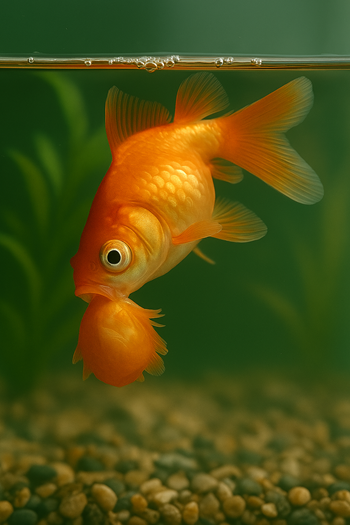
The swim bladder (also called an air bladder) is the buoyancy device that helps a fish stay level and at the depth it wants to be. It inflates when the fish wants to rise and deflates when it wants to sink. In a home aquarium the swim bladder of some fish (especially goldfish, fantails, orandas and black moors) may become over inflated, causing the fish to swim either head up or head down, or even upside down or otherwise unable to stay on an even keel. It may float to the surface and be unable to swim down to the bottom, or it may sink to the bottom and be unable to rise.
Swim bladder problems are very likely to be uncomfortable for the fish, and the fish can become quite distressed. The condition is often caused by the fish suffering from food impaction. This can be avoided by feeding food that sinks, or by soaking the flakes in water for a few minutes before placing the food in the tank. An alternative is to feed only live food since this never becomes impacted. An inflated swim bladder can also be caused by overfeeding the fish, and this can be avoided by making sure you never place more food in the tank than the fish can eat in around two minutes. It is also helpful to regularly fast the fish by not feeding them for at least a day. Fish can live quite happily without food for several days.
In some cases, there is an underlying condition causing the swim bladder problem, such as infestation by parasites or bacteria. It can also be caused by tuberculosis or cancer in organs near the swim bladder. If the fish has swim bladder problems, there is a simple way to fix it in many cases. Nobody seems to know why it works, but it does, probably by loosening food impaction. Take a soft, cooked pea (either fresh, canned or frozen and then cooked), crush it and feed it to the fish. This normally solves the problem within a few hours. If this does not work, do not feed the fish for a few days, since fasting should also clear any food impaction.
As with any other disease or medical condition, it is important to always ensure the water quality in the tank is good. A partial change of water is a good idea, even if the pea trick has worked. Also check the pH and temperature and make sure the water is not too alkaline or too cold. If the problem is caused by a parasite or bacterial infestation, it may be necessary to remove the fish to a separate tank and treat it for these conditions. If none of these measures work, the fish may have a disease such as cancer.
The best way to treat swim bladder problems in most cases is to keep the water quality good and the temperature stable, to give good quality food, which is pre-soaked, and to occasionally feed live food and to occasionally withhold food for a day or so. An occasional treat of a pea or two also helps prevent swim bladder problems.
Provided by Creatures Corner reader Lin Edwards.
Related Articles & Free Email Newsletter Sign Up
How to Cure Common Aquarium Problems
How to Properly Care for Goldfish
Why Snails Can Be a Valuable Aquarium Pet


Comment here